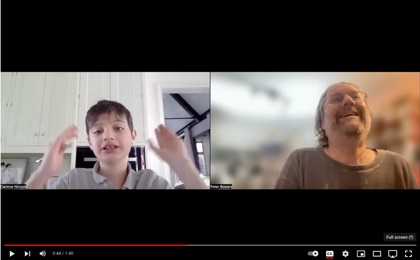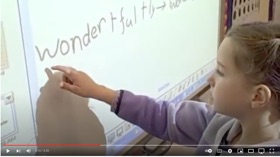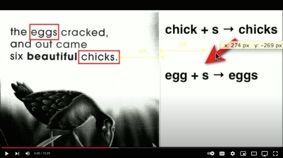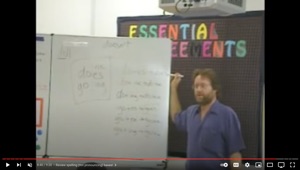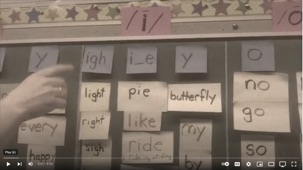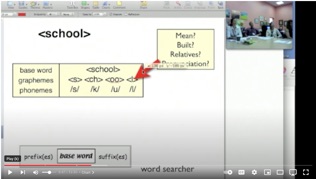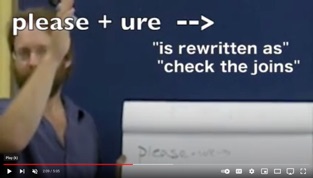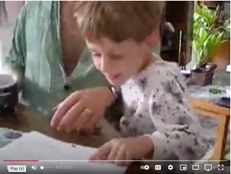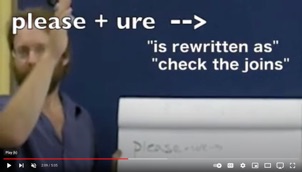
Copyright Susan and Peter Bowers 2008
Spelling-Out Orthography in SWI
I have been refining my practice of “spelling-out orthography” since I encountered Real Spelling in 2001. I addressed this process in the morphological intervention study (Bowers & Kirby, 2010) that introduced the term “structured word inquiry.”
That phrase “spelling-out orthography” is an umbrella term for three practices I use regularly:
-
•Writing-out loud: Done orally in conjunction with writing
-
•Spelling-out loud: Done orally without writing
-
•Tapping-out word structure: Done orally without writing, with tapping of graphemes in the base.
Below you can see a screen shot of a document with a diagram I created as a worked example of the process of spelling-out orthography. The original document has been on my website and a regular feature of my workshops since 2011. I have just revised that document (May 25, 2018) and am posting it at THIS LINK. See a screen shot of one of the diagrams in that document below.
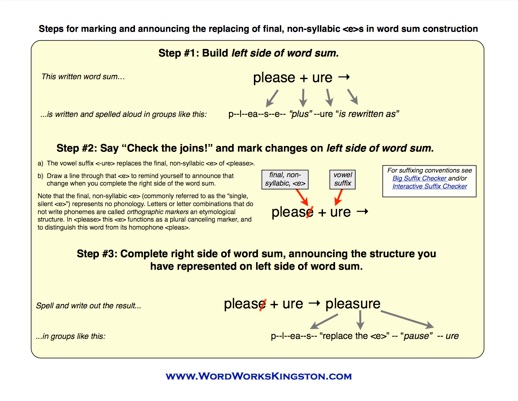
New video on “Spelling-Out Orthography”
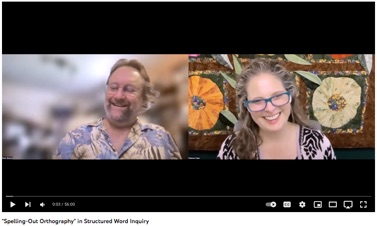
Click HERE for a new video in which Shawna Pope-Jefferson interviews me on “Spelling-Out Orthography.”
This is an in-depth hour-long talk that includes discussing videos of young students using this process. You can see those two videos with students linked below
To jump directly to that part of the interview where Shawna and I watch, pause and discuss those videos, click here.
When I first began using and adapting practices for spelling-out-loud that I saw in Real Spelling I was thinking about it in terms of a useful way to help students focus on the orthographic structures of words in general and especially in the context of working with word sums. Over time I realized that it was an especially important aspect of building teacher’s orthographic learning. When teachers take on the challenge of reflecting these orthographic structures in how the spell-them-out, they are can’t help but find grapheme-phoneme correspondences they are not sure about. And that is a good thing! Spelling-out orthography makes sure we recognize what we don’t yet understand, and tells us what we need to learn.
I use the document above in all my courses on this topic. It lays out the language I use for spelling-out word sums with suffixing changes (replacing final, non-syllabic <e>s, doubling final, single consonants and <y>/<I> changes. Practicing carefully with this guide helps teachers get to the point that they don’t need it in order to spell out the structure of words even without the aid of word sums.
Click HERE for a short YouTube video of two Grade 4 students using this practice she learned from her tutor Jill Gaughan.
In the first video, we see a student start spelling out the word “own.” At first he spells the letters out one-at-a-time. But that process catches his attention and he works hard to show that actually this word starts with an <ow> digraph. Due to Jill’s use of this practice the student instantly recognizes that he has to reflect that new thought by spelling the <ow> together as a group. When Jill asks the teacher about it, he says “Because /oʊ/.” This is his way of explaining that the <ow> digraph is representing the ‘long o’ phoneme. And then they note that /n/ phoneme is represented by the <n> grapheme.
In the second part of the video we see another student correct her recognition of the word that she initially miscues as the word “taping.” We also see that the student can explain her change in thinking because of the suffixing change that she works out without the scaffolding of the written word sum to guide her. She then does the same thing more automatically and with obvious joy with the word “planner.” When teachers take on this practice regularly and help their students do this, they both get constant practice binding graphemes and morphemes into their mental lexicon.
Click HERE for the video (screenshot below) of a tutoring session I did with my student Charlie (Grade 3). In this session we see Charlie use “writing-out-loud” to help him work out the spelling of the word “surface.” See how he self-corrects when he recognizes the spelling-meaning connection between this word and its base <face>. he is also able to clearly articulate the process of his thinking to leverage his morphological knowledge to compensate for his weak phonological processing. Seee a detailed account about this video in the description under the YouTube video.
I am attaching a new 5-page document that attempts to give some more detail on the process, some of my reasoning behind the practice and ways I see it benefit the learning of teachers and students. You can download that document HERE. See a screen shot of the first page below.
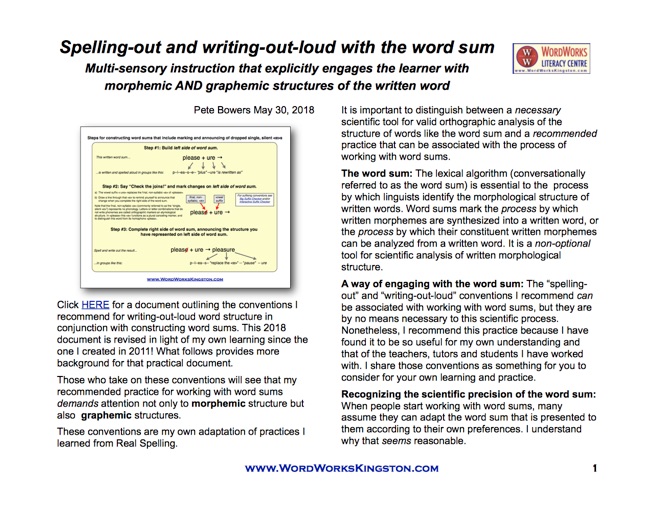
Click screen shots below for more videos incorporating spelling-out orthography in multiple contexts.
Video above, left: Grade 1 student spells out a word sum for “wonderfully.” Notice the cue she gives us with her pause on the left side of the word sum that she’s wondering if there is an <-er> suffix in <wonder>. On the right side of the word sum we see she does not pause before the <er> suggesting that she has decided <wonder> is a base without a suffix. My interpretation is that the act of spelling-out provoked here to notice a possible <-er> suffix, and then she recognized that if that was a suffix in this word, then <wond> would have to be a base. Because she couldn’t make sense of that, she (correctly) concluded the whole word “wonder” is a base. Click HERE.
Video above, right: See me introduce word sums and the matrix to a kindergarten class. In the process, and the <s> grapheme representing both /s/ and /z/, and that we know that we use that <s> for either pronunciation (not the <z> for /z/) if that <s> is a suffix. As one of the students says, “<s> means more!” Click HERE.
Video above, left: I use writing-out-loud with word sums and a matrix on the <do> and <go> family in a lower school class. Click HERE.
Video above, right: Grade 1 teacher Skot Caldwell uses writing-out-loud of graphemes in the base, in word sums to target the binding of grapheme-phoneme correspondences. Wait until the end when we see two students shared their discovery of the <ey> digraph for the ‘long e’ phoneme in the word “monkey’ and were excited to add that to the class chart. Click HERE.
Video above, left: This video is from a session with teachers in which I model using spelling-out-orthography as not only a teaching tool, but also as an assessment tool. Click HERE.
Video above, right: In this video I use the word “pleasure” to model the process of writing-out-loud a word sum. Click HERE.
Video above, left: This is a video of my son Skyler in the first week or two of reading independently. See how leverage spelling-out orthography in the process of reading instruction. Click HERE.
Video above, right: In this video I model the process of writing-out-loud a word sum with the word “pleasure.’ Click HERE.


